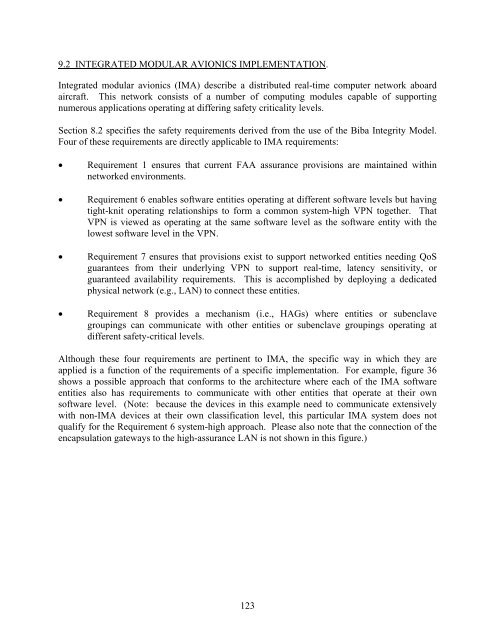Local Area Networks (LANs) in Aircraft - FTP Directory Listing - FAA
Local Area Networks (LANs) in Aircraft - FTP Directory Listing - FAA
Local Area Networks (LANs) in Aircraft - FTP Directory Listing - FAA
You also want an ePaper? Increase the reach of your titles
YUMPU automatically turns print PDFs into web optimized ePapers that Google loves.
9.2 INTEGRATED MODULAR AVIONICS IMPLEMENTATION.<br />
Integrated modular avionics (IMA) describe a distributed real-time computer network aboard<br />
aircraft. This network consists of a number of comput<strong>in</strong>g modules capable of support<strong>in</strong>g<br />
numerous applications operat<strong>in</strong>g at differ<strong>in</strong>g safety criticality levels.<br />
Section 8.2 specifies the safety requirements derived from the use of the Biba Integrity Model.<br />
Four of these requirements are directly applicable to IMA requirements:<br />
• Requirement 1 ensures that current <strong>FAA</strong> assurance provisions are ma<strong>in</strong>ta<strong>in</strong>ed with<strong>in</strong><br />
networked environments.<br />
• Requirement 6 enables software entities operat<strong>in</strong>g at different software levels but hav<strong>in</strong>g<br />
tight-knit operat<strong>in</strong>g relationships to form a common system-high VPN together. That<br />
VPN is viewed as operat<strong>in</strong>g at the same software level as the software entity with the<br />
lowest software level <strong>in</strong> the VPN.<br />
• Requirement 7 ensures that provisions exist to support networked entities need<strong>in</strong>g QoS<br />
guarantees from their underly<strong>in</strong>g VPN to support real-time, latency sensitivity, or<br />
guaranteed availability requirements. This is accomplished by deploy<strong>in</strong>g a dedicated<br />
physical network (e.g., LAN) to connect these entities.<br />
• Requirement 8 provides a mechanism (i.e., HAGs) where entities or subenclave<br />
group<strong>in</strong>gs can communicate with other entities or subenclave group<strong>in</strong>gs operat<strong>in</strong>g at<br />
different safety-critical levels.<br />
Although these four requirements are pert<strong>in</strong>ent to IMA, the specific way <strong>in</strong> which they are<br />
applied is a function of the requirements of a specific implementation. For example, figure 36<br />
shows a possible approach that conforms to the architecture where each of the IMA software<br />
entities also has requirements to communicate with other entities that operate at their own<br />
software level. (Note: because the devices <strong>in</strong> this example need to communicate extensively<br />
with non-IMA devices at their own classification level, this particular IMA system does not<br />
qualify for the Requirement 6 system-high approach. Please also note that the connection of the<br />
encapsulation gateways to the high-assurance LAN is not shown <strong>in</strong> this figure.)<br />
123
















